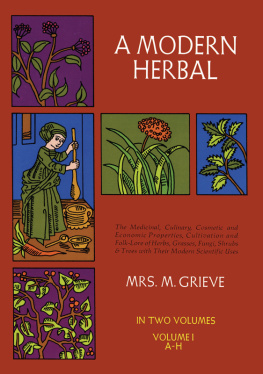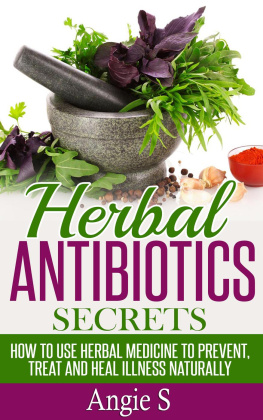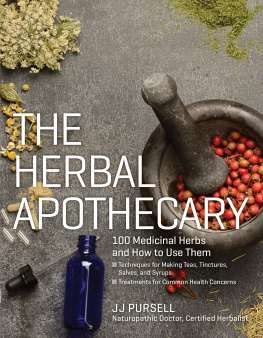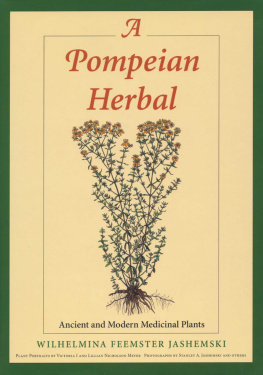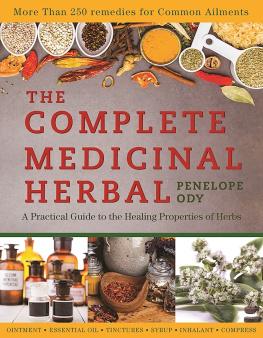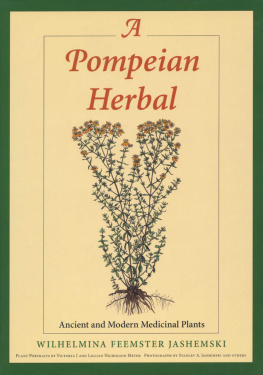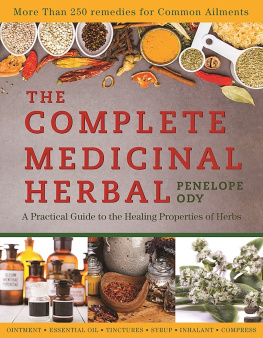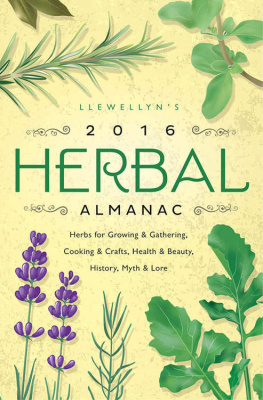A
MODERN HERBAL
THE MEDICINAL, CULINARY, COSMETIC AND
ECONOMIC PROPERTIES, CULTIVATION
AND FOLK-LORE OF
HERBS, GRASSES, FUNGI
SHRUBS & TREES
WITH
ALL THEIR MODERN SCIENTIFIC
USES
By
MRS. M. GRIEVE
F.R.H.S.
WITH AN INTRODUCTION BY THE EDITOR
MRS. C. F. LEYEL
IN TWO VOLUMES
Vol. I
(A-H)
DOVER PUBLICATIONS, INC.
NEW YORK
This Dover edition, first published in 1971, is an unabridged
republication of the work originally published by
Harcourt, Brace & Company in 1931.
In 1982 a new Index of Scientific Names compiled by
Manya Marshall was added to Volume II of this work.
Library of Congress Catalog Card Number: 72-169784
International Standard Book Number
ISBN-13: 978-0-486-22798-6
ISBN-10: 0-486-22798-7
Manufactured in the United States by Courier Corporation
22798727
www.doverpublications.com
CONTENTS
BIBLIOGRAPHICAL NOTE
I T is impossible to give a complete list of the works consulted for reference in the compiling of this H ERBAL.
Mrs. Grieve has of course drawn her knowledge from books as well as from plants.
As Editor I have confirmed her facts with those in Bentley and Trimens Medicinal Plants in four volumes, Clarkes Dictionary of Materia Medica in three volumes, and Potters Cyclopdia of Botanical Drugs and Preparations.
I have also consulted Anne Pratts Flowering Plants of Great Britain in four volumes, Stephenson and Churchills Medical Botany in three volumes, Dr. Fernies Herbal Simples, Rhinds History of the Vegetable Kingdom, and the English and French official Pharmacopias.
HILDA LEYEL
EDITORS INTRODUCTION
B OTANY and medicine came down the ages hand in hand until the seventeenth century; then both arts became scientific, their ways parted, and no new herbals were compiled. The botanical books ignored the medicinal properties of plants and the medical books contained no plant lore.
The essence of a herbal was the combination of traditional plant lore, the medicinal properties of the herbs, and their botanical classification. From the time of Dioscorides down to Parkinson in 1629 this herbal tradition was unbroken. Culpepers popular herbal was discredited with scientific people because it was astrological.
The death of the herbal was one of the reasons why, with a few exceptions, the only plants which have retained their place in the Allopaths Pharmacopias are poisonous ones like Aconite, Belladonna, Henbane and the Opium Poppy.
Dandelion, Gentian and Valerian for some reason have survived and the Homeopaths use many more, but such useful plants as Agrimony, Slippery Elm, Horehound, Bistort, Poplar, Bur Marigold, Wood Betony, Wood Sanicle, Wild Carrot, Raspberry leaves, and the Sarsaparillas are now only used by Herbalists.
All serious Herbalists have long realized that a new Herbal is badly needed a herbal which must include the traditional lore and properties of plants, and the modern use of properly standardized extracts and tinctures which were unknown in the days of Gerard and Parkinson, and even in the days of Culpeper, and which have been made possible by the development of modern chemistry.
The interest for the amateur can only be an historical one, because the herbal tinctures and extracts are too potent to be prescribed or experimented with by the unskilled or the inexperienced; in fact, it is as dangerous for amateurs to doctor themselves indiscriminately with herbs, as it would be for them to administer drugs in their alkaloid form.
A knowledge of herbs is as necessary as a knowledge of Pathology, if herbal treatment for all but the simplest ailments is to be successful.
Each herb has its own indications for use, and successful prescribing depends upon the correspondence between these indications and the patients symptoms. Then, and only then, will the result be altogether successful.
Most of the modern scientific work on the right use of herbs we owe to Hahnemann and his successors.

That famous head master, Edward Thring, first taught me botany when I was a baby, in the School House garden and Uppingham fields. I still remember the pride I felt when he strapped the black japanned tin lined with green to my tiny back, and though at the time I was only four and much too young to enjoy searching in the heat for rare plants like Ladies Tresses and Green Hellebore, the names of the plants, like the dates of the English kings, were impressed upon my mind so vividly that it has been impossible for me ever to forget them.
After Edward Thrings death, his daughter Sarah carried on my lessons, and I have never lost touch with the subject.
At one time there was an idea of my entering the medical profession, but I was put off by my first lesson in dissection.
I have always experimented in the innocent alchemy of scent blending and cooking, but it was not until I had written my first book on herbs that the idea came to me to found the Society of Herbalists, and since 1926 I have done nothing else but research work in herbal medicine.
Just before I opened Culpeper House, a list of Mrs. Grieves monographs on herbs came to me through the post. I made her acquaintance, and after examining the pamphlets, thought they might be the nucleus of the much-needed modern herbal.
I took the monographs and the suggestion to Mr. Cape, who agreed to publish them if I would collate and edit them and see that the American herbs were also included.
Mrs. Grieves original pamphlets only included the English herbs, many of which she grew in her Buckinghamshire garden.
During the War, when there was a shortage of medicinal plants because they could no longer be imported from abroad, Mrs. Grieve made practical use of her knowledge and trained pupils in the work of drying and preparing herbs for the chemists market.
She did a great deal to revive the herb industry in England.
The arrangement and the editing of the vast quantity of material which Mrs. Grieve had accumulated has been a task of some difficulty. I have arranged the plants alphabetically under their most familiar names, hoping to interest flower-lovers as well as doctors, and in this way they are as easily found as the words in a dictionary. The country names are in the index.
This is not the orthodox arrangement either from the Herbalists, or the Homeopaths, or the Allopaths, point of view.
Herbalists talk about Jalap and Black Haw, but to the uninitiated Bindweed and Guelder Rose are far more familiar, and it is under these names that they will be found in this herbal.
In homeopathy the Anemone and the Forget-me-not are known as Pulsatilla and Myosotis, and chemists accustomed to the Latin names may be shocked to find Taraxacum under Dandelion, Podophyllum under Mandrake, and Calendula under Marigold.
The very names of the plants are so interesting; the names are often derived from their original use in medicine, and the traditional use has been derived from some peculiarity of the plant based on the doctrine of signatures, its shape, growth, colour, scent or taste, or habitat.
For instance, the flower of the Scullcap, one of the best cures for insomnia, has a strong resemblance to the shape of the human skull. The Yellow Cedar has a curious sinister appearance and is used to cure fungoid growths. The little blue flower of the Eye- bright with its yellow centre suggests the human eye, and is so useful for tired eyes that the French have called it casse lunettes.
The flowers of many of the herbs which purify the blood are red in colour, e.g. the Scarlet Pimpernel, the Burdock, the Red Clover.
Next page
